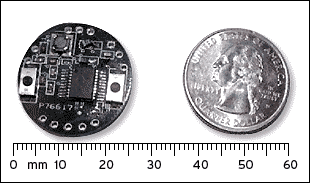RFID engineering company SkyeTek says it has developed the world’s smallest RFID reader. Dubbed the SkyeRead M1-mini, the new device measures 1 inch in diameter and 0.1 inch in thickness. The company says the reader’s small dimensions make it suitable for a range of size-sensitive mobile RFID applications.
“The M1-mini enables readers to be deployed anywhere space is a concern. It can be embedded in handheld and mobile computing devices as well as key fobs, shelves and appliances,” says Sean Loving, who founded the Boulder, Colo.-based SkyeTek in 2000. One potential application, says Loving, is putting the device into printers to monitor toner cartridges made with an embedded RFID tag. The tag in the cartridge could contain a unique code verifying that the cartridge is genuine and not counterfeit, and the tag could also be linked to a sensor within the cartridge that monitors the toner level and sends an alert when the cartridge needs to be replaced.
SkyeTek’s original SkyeRead M1 reader, which is three times larger than the new M1-mini, was developed and tested as part of a smart home facility at the Intel Research Seattle Lab. At the Intel lab, the reader was built into a glove that could then be used to detect and react to tags around the glove. According to SkyeTek, the glove has shown how the tiny reader can be used to read tags on items such as pharmaceutical containers to warn wearers if they are about to take the wrong medication. The glove also has industrial applications.
“This can be applied in manufacturing, too, as a way to provide a warning if an operator wearing such a glove starts to fix the wrong capacitors in computer motherboards on the production line. Errors like that can cost millions in lost goods,” says Loving. Such a warning would be generated because the glove’s M1-mini would read tags attached to motherboard components, and those readings would be checked against a range of situations via a network connection linking the reader to a larger network. If the glove’s wearer is about to make a mistake, an alert could then be delivered a variety of ways, including a sound or light alarm.
The M1-mini can be wired to a source of DC power or use an internal button battery. The battery life can last for well over two weeks of operation. The new SkyeRead M1-mini offers a read rate of 20 tags per second, and can read a tag up 2.5 inches away using its internal antenna or up to 5 inches away using an external 6-inch-diameter antenna. The M1-mini operates at 13.56 frequency and can read and write to EPC tags and smart labels as well as tags complying with the ISO15693, ISO14443 and ISO18000 standards. That means the reader can work with Texas Instruments’ Tag-It tags, Philips’ I-Code and Mifare designs, Infineon’s My-d tags, Inside Contactless’ PicoTag products, and other manufacturers’ tags and labels.
SkyeTek claims its SkyeRead M1-mini is far smaller than RFID readers offered by its competitors. WJ Communications makes a small reader for Alien Technology. AWID and Syscan International offer 13.56 MHz readers in a PCMCIA card, but those readers are larger than the SkyeRead M1-mini or even the original SkyeRead M1, according to the company.
“Our M1 was previously the smallest reader on the market, and the M1-mini is a third the size of the M1,” says Loving. Size isn’t the only difference between the M1-mini and other readers, according to Jonathan Bein, president at SkyeTek, who notes that rival readers don’t have a built-in antenna and can’t accept an internal battery.
Using a wireless host-interface option, the SkyeRead M1-mini can connect to a computer network or to mobile computing devices such as PDAs. The SkyeRead M1-mini was also designed to connect with Mica2Dot motes from Crossbow Technology, which has worked alongside SkyeTek at Intel’s research lab. Motes (also known as smart dust) are small devices that combine RF transceivers with sensors. The sensors can detect or measure things such as vibrations, magnetic disturbances, light and temperature. Multiple motes can be used to create a wireless-mesh network to pass along data collected by the sensors and eventually to an RF receiver such as the M1-mini.
The SkyeRead M1-mini is now available in prototype quantities, with full production scheduled for March 1. Pricing will range from $142 for a single reader to $70 each for quantities of 1,000 or more. That is around a 25 percent premium over the company’s existing SkyeRead M1 reader.
SkyeTek has already lined up one customer for its technology and SkyeRead M1-mini reader: Socket Communications, an electronics manufacturer based in located in Newark, Calif. Socket has an exclusive license to develop the SkyeRead M1-mini reader for mobile computing and handheld devices. According to Socket, the M1-mini’s small size and low power consumption make it suitable for a range of planned Compact Flash readers as well as potential readers in the Secure Digital card format. Socket, which already produces an array of bar code readers and other communications devices that can be added to mobile computing and handheld devices, says it expects to have its first RFID offerings, which will be built around SkyeTek’s readers, ready for sale in the second half of this year.
Register for RFID Journal Live! 2004 (Chicago Hilton, March 29 to 31) before Feb. 2 and save up to $500.


